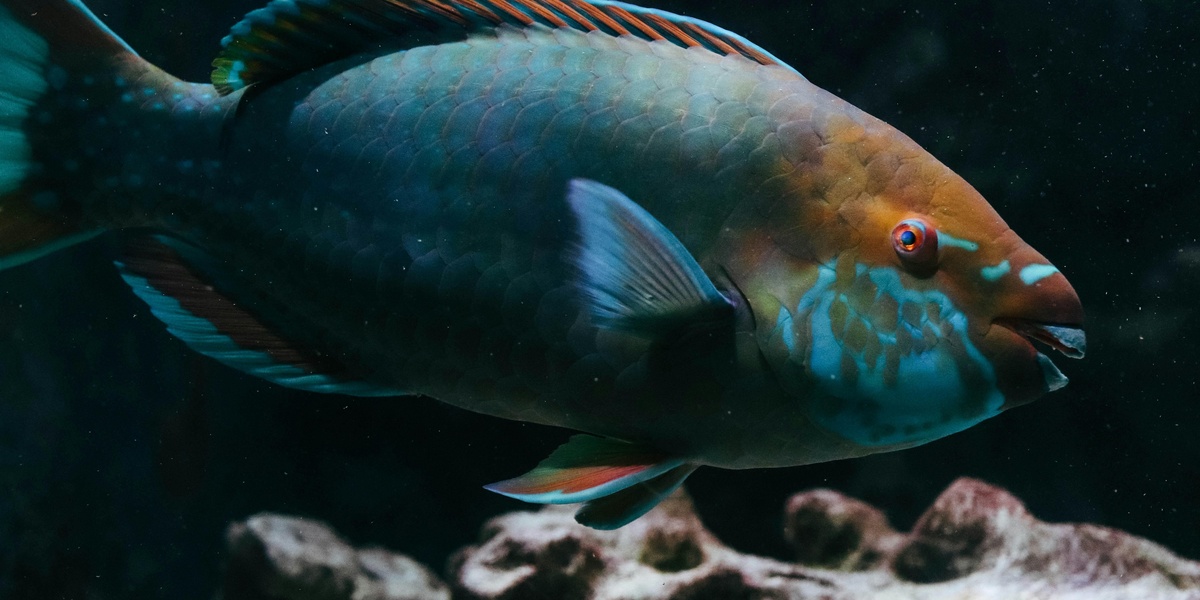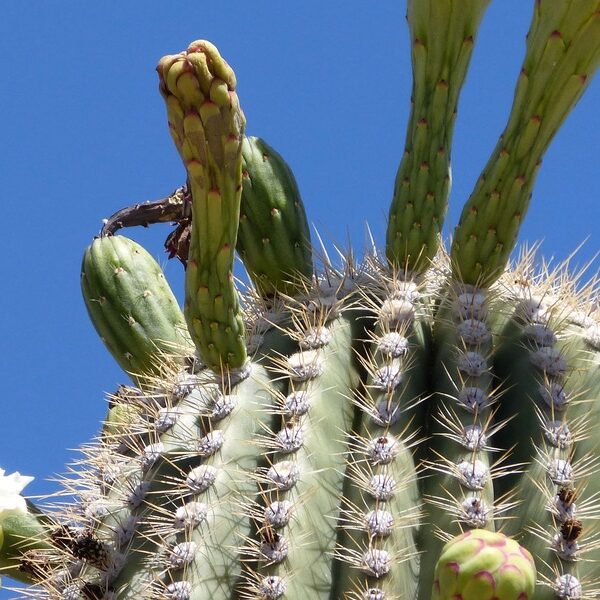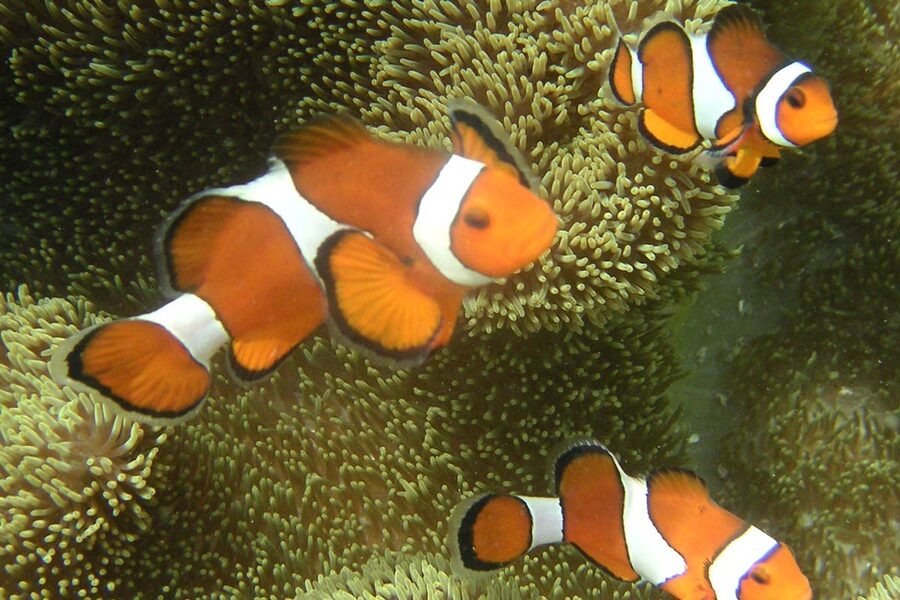Polynesia, with its crystal-clear waters and vibrant coral reefs, is home to an incredible array of marine species. From tiny, colorful reef fish to powerful pelagics, the biodiversity here is a testament to the health and richness of its oceanic ecosystems, captivating divers and researchers alike.
This extensive guide delves into the remarkable marine life found across these islands. Here, you’ll discover 49 Fish of Polynesia, showcasing a wide variety from the commonly seen Bigeye scad to the impressive Yellowtail amberjack. For each entry, we’ve organized the details by Scientific Name, Max Length (cm), and Typical Habitat, providing a clear and comprehensive overview you’ll find below.
What makes the marine life in Polynesia so diverse?
Polynesia’s incredible marine diversity stems from a combination of factors, including its vast geographic spread across the Indo-Pacific, its warm, nutrient-rich waters, and the abundance of diverse habitats like coral reefs, lagoons, and deep-sea trenches. These elements create numerous ecological niches, fostering the evolution and coexistence of a wide array of fish species.
Are many of these Polynesian fish unique to the region?
Yes, due to its significant geographic isolation, Polynesia boasts a notable percentage of endemic fish species, meaning they are found exclusively in these waters and nowhere else in the world. This isolation has allowed distinct evolutionary pathways to develop, contributing to the unique character and biological importance of its marine fauna.
Fish of Polynesia
| Fish Name | Scientific Name | Max Length (cm) | Typical Habitat |
|---|---|---|---|
| Convict tang | Acanthurus triostegus | 27 | Coral reefs and lagoons |
| Blue tang | Paracanthurus hepatus | 30 | Coral reefs and reef slopes |
| Yellowfin surgeonfish | Acanthurus xanthopterus | 70 | Outer reefs and nearshore waters |
| Brown tang | Zebrasoma scopas | 25 | Fringing reefs and seagrass beds |
| Yellow tang | Zebrasoma flavescens | 20 | Hawaiian reef flats and lagoons |
| Bullethead parrotfish | Chlorurus sordidus | 45 | Coral reef slopes and lagoon zones |
| Bridled parrotfish | Scarus frenatus | 30 | Reef crests and shallow lagoons |
| Napoleon wrasse | Cheilinus undulatus | 250 | Coral reefs and steep outer slopes |
| Raccoon butterflyfish | Chaetodon lunula | 23 | Coral-rich reef zones |
| Threadfin butterflyfish | Chaetodon auriga | 23 | Reefs, lagoons and seagrass edges |
| Moorish idol | Zanclus cornutus | 25 | Reef slopes and drop-offs |
| Clark’s anemonefish | Amphiprion clarkii | 17 | Shallow reefs with anemones |
| Blue-green chromis | Chromis viridis | 10 | Lagoon waters and reef slopes |
| Whitetail dascyllus | Dascyllus aruanus | 10 | Shallow reef crevices and branching corals |
| Honeycomb grouper | Epinephelus merra | 40 | Reef caves, ledges and lagoon slopes |
| Brown-marbled grouper | Epinephelus fuscoguttatus | 100 | Coral reefs and sheltered lagoons |
| Bluestripe snapper | Lutjanus kasmira | 35 | Reef slopes, lagoons and seaward reefs |
| Yellowstripe goatfish | Mulloidichthys flavolineatus | 35 | Sandy bottoms near reefs and lagoons |
| Dash-and-dot goatfish | Parupeneus barberinus | 60 | Reef flats and sandy channels |
| Moon wrasse | Thalassoma lunare | 25 | Reef flats and surge zones |
| Surge wrasse | Thalassoma purpureum | 25 | Reefs and lagoon patch reefs |
| Squirrelfish (spiny) | Sargocentron spiniferum | 35 | Reef crevices and night-time habitats |
| Lionfish | Pterois volitans | 38 | Coral reefs and rocky outcrops |
| Flathead grey mullet | Mugil cephalus | 60 | Lagoons, estuaries and nearshore waters |
| Giant moray | Gymnothorax javanicus | 300 | Reef crevices, caves and drop-offs |
| Yellowtail amberjack | Seriola lalandi | 150 | Pelagic waters and nearshore reefs |
| Yellowfin tuna | Thunnus albacares | 240 | Open ocean and pelagic waters |
| Skipjack tuna | Katsuwonus pelamis | 100 | Warm open ocean and surface waters |
| Bigeye tuna | Thunnus obesus | 200 | Deep pelagic waters near islands |
| Wahoo | Acanthocybium solandri | 200 | Pelagic waters near currents and reefs |
| Mahi-mahi | Coryphaena hippurus | 200 | Surface pelagic waters and floating debris |
| Blue marlin | Makaira nigricans | 400 | Open ocean and offshore waters |
| Sailfish | Istiophorus platypterus | 290 | Open ocean and migratory routes |
| Giant trevally | Caranx ignobilis | 170 | Reef slopes, surf zones and lagoons |
| Bluefin trevally | Caranx melampygus | 80 | Coral reefs and lagoon passages |
| Great barracuda | Sphyraena barracuda | 165 | Nearshore waters and coral reef margins |
| Blacktip reef shark | Carcharhinus melanopterus | 175 | Shallow reefs, lagoons and reef flats |
| Grey reef shark | Carcharhinus amblyrhynchos | 230 | Outer reef slopes and drop-offs |
| Oceanic manta ray | Mobula birostris | 700 | Open ocean, cleaning stations and coastal reefs |
| Spotted eagle ray | Aetobatus narinari | 240 | Lagoon edges, reef flats and open coasts |
| Flying fish | Exocoetus volitans | 35 | Surface pelagic waters and around islands |
| Bigeye scad | Selar crumenophthalmus | 40 | Reef-associated pelagic waters |
| Mackerel scad | Decapterus macarellus | 35 | Open water near reefs and island shelves |
| Leopard coral grouper | Plectropomus leopardus | 100 | Coral reefs and drop-offs |
| White-spotted rabbitfish | Siganus canaliculatus | 40 | Seagrass beds and sheltered reef flats |
| Bluespine unicornfish | Naso unicornis | 100 | Reef slopes and outer reef areas |
| Greenband parrotfish | Scarus rubroviolaceus | 65 | Reef slopes and mixed coral habitats |
| Picasso triggerfish | Rhinecanthus aculeatus | 30 | Shallow reefs, reef flats and lagoons |
| Spanish mackerel | Scomberomorus commerson | 140 | Coastal pelagic waters and around island shelves |
Images and Descriptions
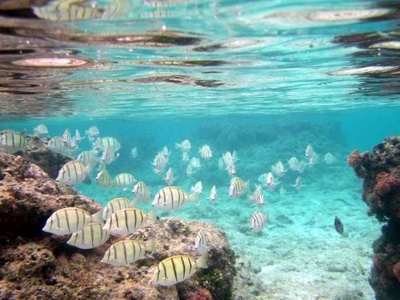
Convict tang
A small, boldly striped surgeonfish common on shallow reef flats and lagoon patch reefs. Grazes algae in large schools, helping keep coral surfaces clean and playing a vital ecological role across Polynesian islands.
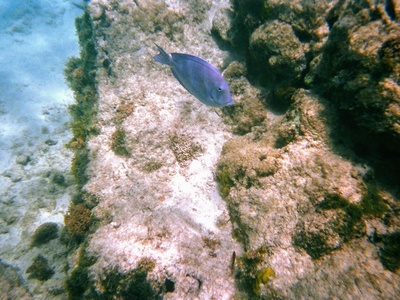
Blue tang
Bright blue plate-shaped surgeonfish that lives in small groups on coral reefs. Known for its striking color and role as a grazer, it’s familiar to snorkelers and plays an important part in reef algal control.
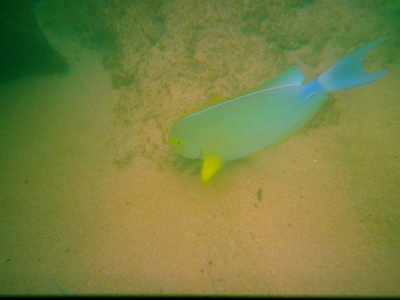
Yellowfin surgeonfish
A large, fast-moving surgeonfish found around reef drop-offs and lagoons. Omnivorous and powerful, it forages on algae and small animals; culturally and ecologically significant across many Polynesian islands.
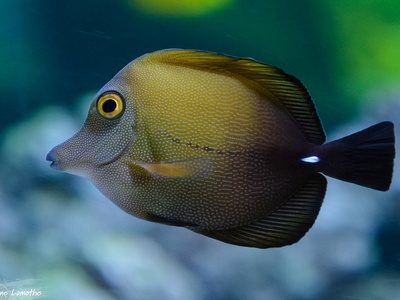
Brown tang
A brown, laterally compressed tang that frequents sheltered reef slopes and seagrass areas. Feeds on algae, often seen singly or in small groups, and recognized for its graceful swimming and important grazing habits.
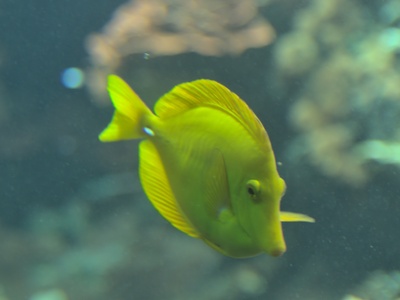
Yellow tang
Iconic bright yellow surgeonfish largely associated with Hawaiian reefs but part of Polynesia. Lives in shallow reefs where it grazes algae; culturally familiar and often seen by snorkelers and divers.
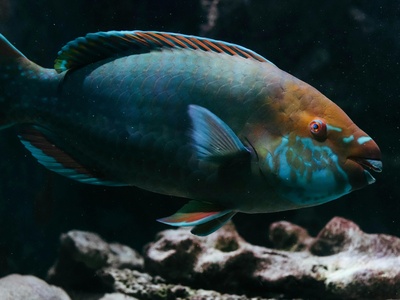
Bullethead parrotfish
Robust parrotfish that scrapes algae and coral, producing sand through digestion of coral substrate. Important for reef bioerosion and sediment production, commonly seen in shallow to mid-depth reefs across Polynesia.
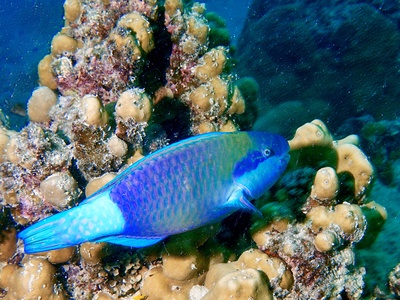
Bridled parrotfish
A medium-sized parrotfish with vibrant bands and an important grazing role. Active during daylight, it sleeps in reef crevices at night and helps maintain coral–algae balance on reefs.
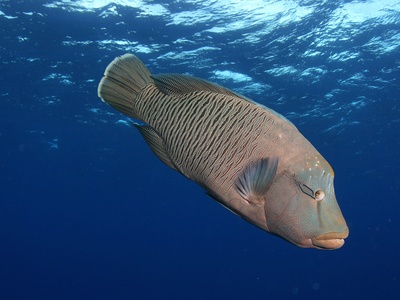
Napoleon wrasse
A charismatic, large wrasse famous for its bulbous forehead and longevity. Feeds on hard-shelled invertebrates and sometimes prized by fishers; vulnerable in many areas and often protected for ecological reasons.
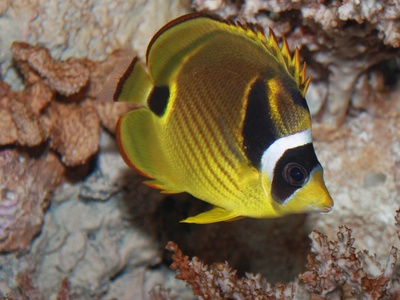
Raccoon butterflyfish
Distinctive black-and-white masked butterflyfish that feeds on invertebrates and coral mucus. Agile and common on diverse reef slopes, often seen in pairs and recognized by its striking facial banding.
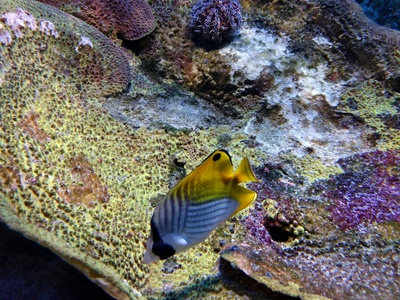
Threadfin butterflyfish
Oval-bodied butterflyfish with eye-catching diagonal bands and a trailing filament. Feeds on small invertebrates and coral polyps; a familiar sight on Polynesian reef flats and lagoon margins.
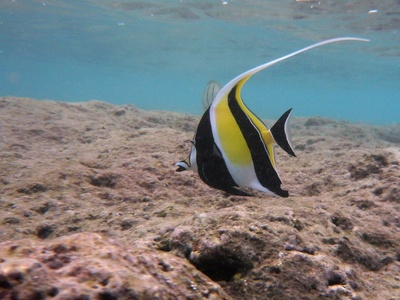
Moorish idol
A boldly patterned, laterally compressed reef fish with a long dorsal filament. Known for being difficult to keep in aquaria, it grazes sponges and small invertebrates on reefs and is visually iconic.
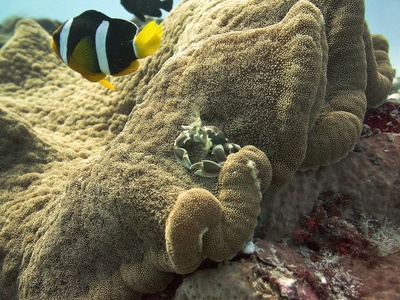
Clark’s anemonefish
A hardy, variable-colored anemonefish commonly found in shallow lagoons and reef crests. Lives symbiotically with sea anemones, is culturally familiar, and exhibits interesting social and breeding behaviors.
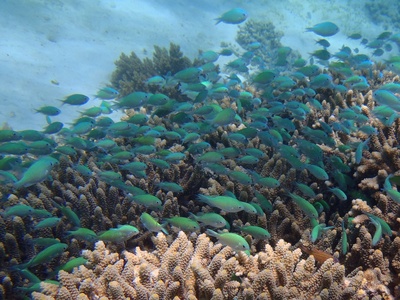
Blue-green chromis
Small, peaceful schooling damselfish that forms shimmering clouds above coral heads. Feeds on plankton, provides prey for larger species, and is a common sight in sheltered lagoon environments throughout Polynesia.
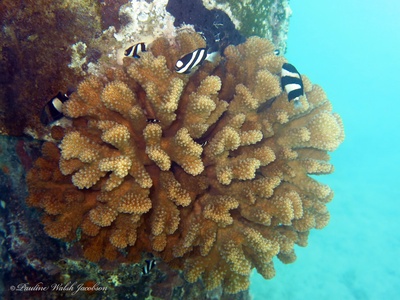
Whitetail dascyllus
A small, bold damselfish that shelters in branching corals and anemones. Often aggressive for its size, it defends territory and is a familiar character of shallow Polynesian reefs.
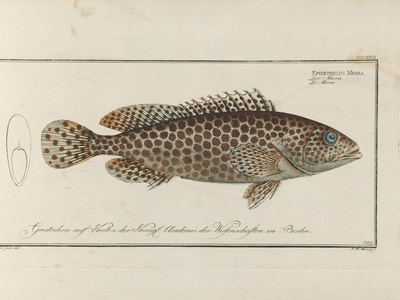
Honeycomb grouper
A small-to-medium grouper with a mottled honeycomb pattern. Ambush predator feeding on smaller reef fishes, it shelters in caves and overhangs; important in local subsistence fisheries.
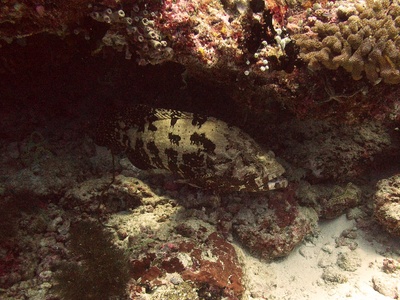
Brown-marbled grouper
A larger, commercially valuable grouper inhabiting reef slopes and lagoon edges. Slow-growing and long-lived, it’s a sought-after species by fishers and an important predator on coral reefs.
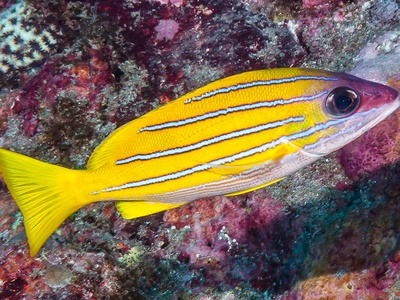
Bluestripe snapper
A colorful schooling snapper often seen in large aggregations above reefs. Feeds on small fishes and invertebrates, important both ecologically and as a subsistence species for island communities.
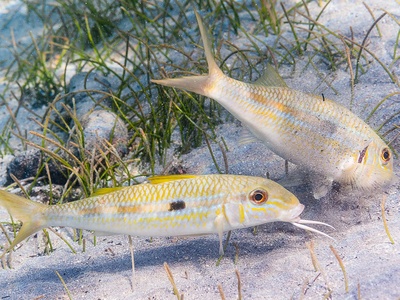
Yellowstripe goatfish
A distinctive goatfish with a yellow lateral stripe that probes sand with a chin barbel for invertebrates. Often forms feeding groups around reef margins, contributing to benthic turnover.
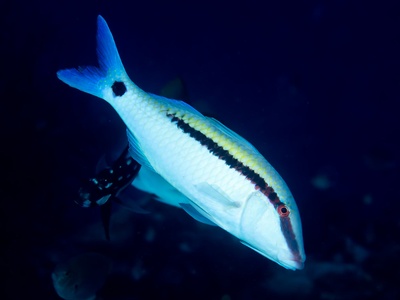
Dash-and-dot goatfish
Larger goatfish notable for searching the sand with barbels. Feeds on worms and crustaceans, frequently seen leading cleaning fish and foraging in small groups close to reefs.
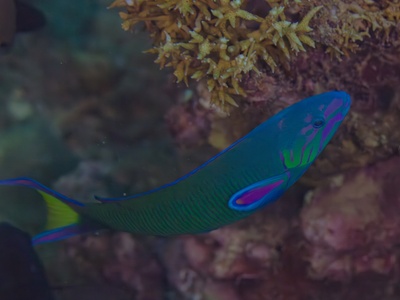
Moon wrasse
Colorful, active wrasse frequenting shallow, turbulent reef areas. Eats small invertebrates and fish, often seen darting among corals and cleaning stations; males and females show dramatic coloration differences.
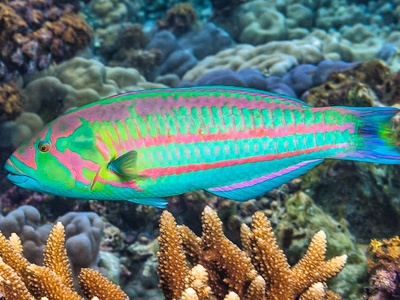
Surge wrasse
A brightly colored wrasse common on shallow reefs, where it hunts small invertebrates. Displays rapid movements and complex social behaviors, playing a role in controlling reef invertebrate populations.
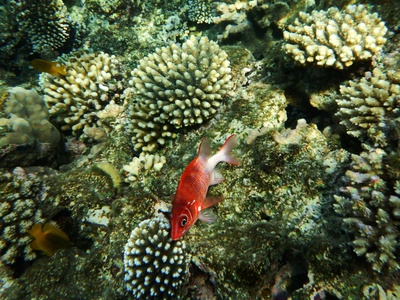
Squirrelfish (spiny)
Red, large-eyed nocturnal predator that shelters in caves and under ledges by day. Emerges at night to hunt crustaceans and small fish, producing a characteristic clicking sound.
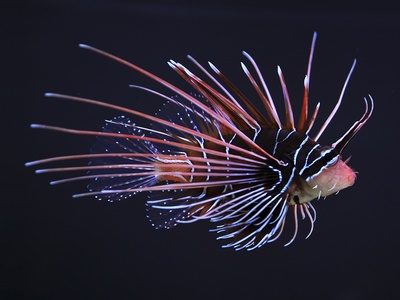
Lionfish
Venomous, ambush predators with striking fin display. Native to the Indo-Pacific and common on reefs, they feed on small fish and invertebrates; visually dramatic and ecologically significant.
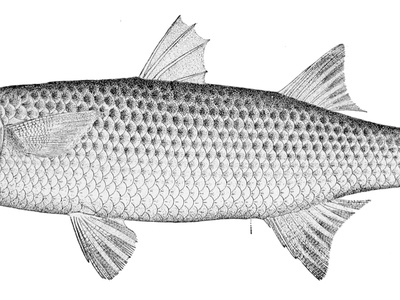
Flathead grey mullet
A robust coastal species often found in seagrass beds and estuaries. Feeds on detritus and microalgae; culturally important as a traditional food fish across Polynesian communities.
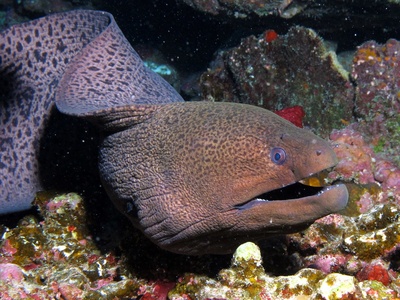
Giant moray
Imposing, toothy eel that hides in reef crevices and ambushes prey at night. Plays a top-predator role on reefs; frequently photographed by divers due to its large size and curious behavior.
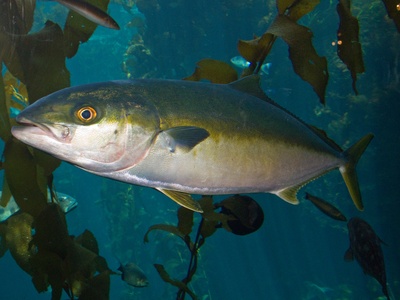
Yellowtail amberjack
A large, fast, schooling pelagic predator found near islands and seamounts. Valued in sport and subsistence fisheries, it chases smaller fish and squid around reef margins.
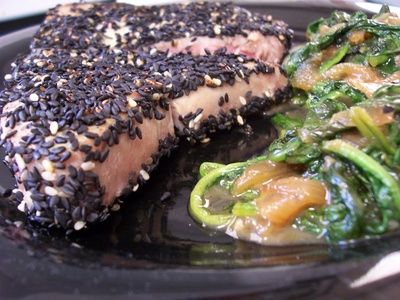
Yellowfin tuna
An economically and culturally vital large tuna that inhabits warm tropical and subtropical waters. Fast-swimming and migratory, it’s central to Polynesian fisheries and offshore food traditions.
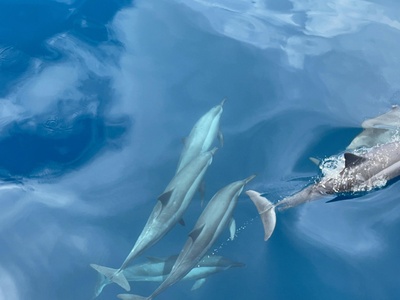
Skipjack tuna
A small, abundant tuna species that forms large schools. Highly important for local and commercial fisheries, it feeds on small fish and plankton near islands and floating debris.
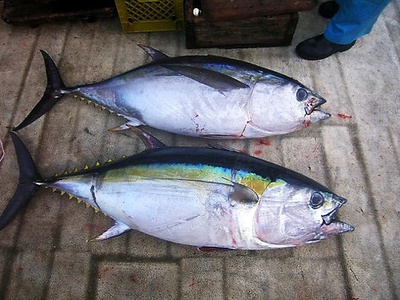
Bigeye tuna
A deep-swimming tuna with large eyes adapted to low light. An important commercial species in Polynesia, it frequents deeper offshore waters and seamounts around island chains.
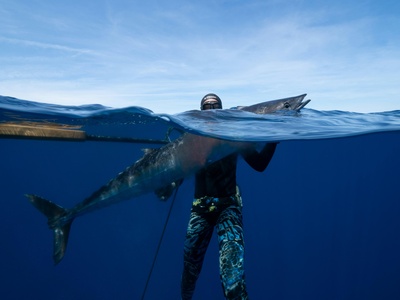
Wahoo
A streamlined, high-speed pelagic predator prized by anglers. Often found near fronts, floating debris, and island edges, it feeds on schooling fishes and displays spectacular bursts of speed.
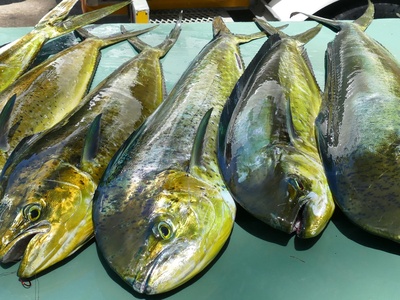
Mahi-mahi
Vividly colored, fast-growing pelagic fish associated with floating objects and sargassum. Popular for sport and food, it’s known for rapid growth and spectacular leaping when hooked.
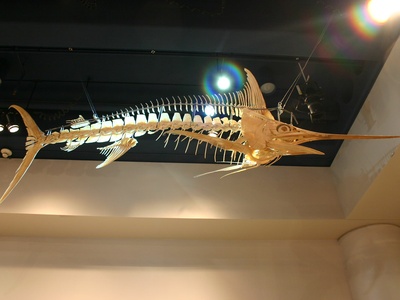
Blue marlin
Iconic large billfish central to sportfishing and ocean ecosystems around Polynesian islands. Powerful and migratory, it preys on large pelagic fishes and is a storied species in island fishing traditions.
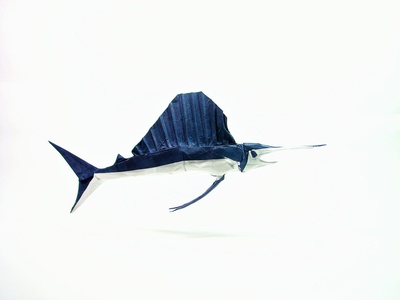
Sailfish
A spectacular, sail-backed predator that cruises tropical oceans. Known for speed and acrobatic fighting ability, sailfish frequent currents and upwellings around Polynesian islands and seamounts.
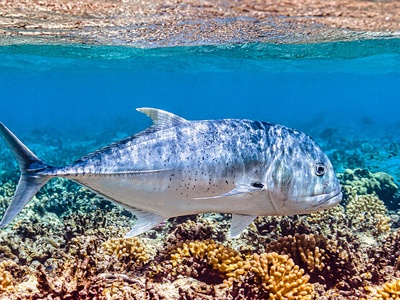
Giant trevally
A powerful top predator common around rocky points and reef drop-offs. Feared and revered by fishers, it hunts fish and crustaceans and is a cultural icon in many island communities.
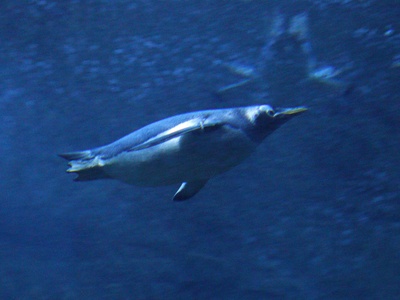
Bluefin trevally
Strikingly blue-finned predator that patrols reef edges and passes. Agile and highly sought by anglers, it feeds on fish and invertebrates and often hunts in ambush.
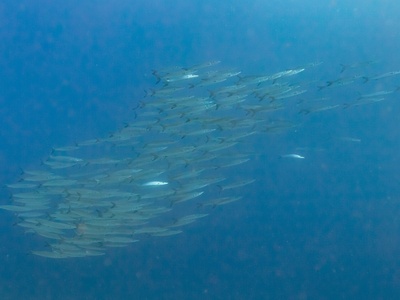
Great barracuda
An opportunistic, torpedo-shaped predator that stalks reefs and coastal waters. Known for speed and large size, barracuda are a dramatic sight and important mid-level predators in Polynesian seas.
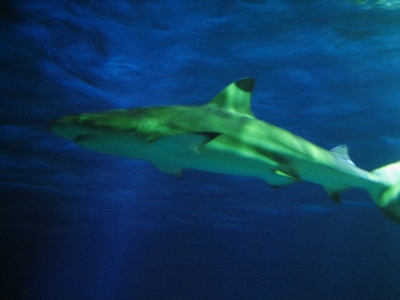
Blacktip reef shark
A familiar small reef shark that frequents shallow waters and reef flats. Commonly seen by snorkelers and divers, it plays a key role in reef food webs while usually posing little threat to people.
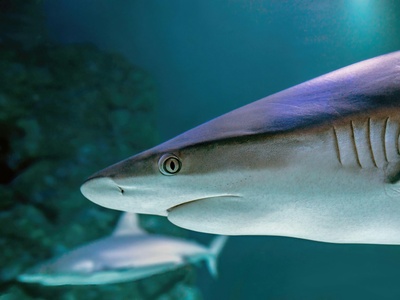
Grey reef shark
A dominant predatory shark of outer reefs, commonly encountered at cleaning stations and along drop-offs. Important apex predator that influences reef community structure and behavior.
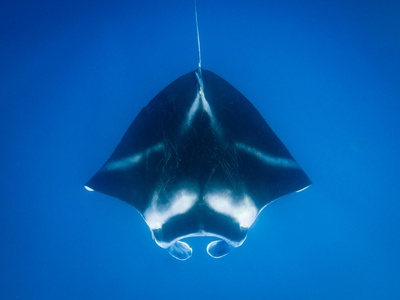
Oceanic manta ray
A giant, filter-feeding ray that glides over reef slopes and pelagic seas to feed on plankton. Often visits cleaning stations and is a major draw for eco-tourism and cultural reverence.
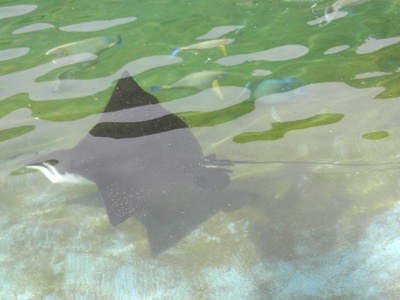
Spotted eagle ray
Graceful, long-winged ray found around reefs and sandbanks. Feeds on mollusks and crustaceans by crushing shells; valued by divers for its elegant swimming and frequent sightings near islands.
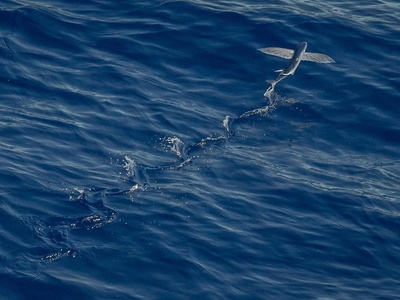
Flying fish
Small, streamlined fish that glide above the water on enlarged fins to escape predators. Common around islands and atolls, they are culturally important as forage for larger predators and for traditional fishing.
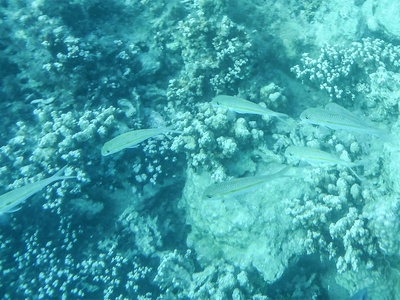
Bigeye scad
A schooling, silver carangid found near reefs and around lights at night. Important forage species for larger predators and commonly used as bait and food by local fishers across Polynesia.
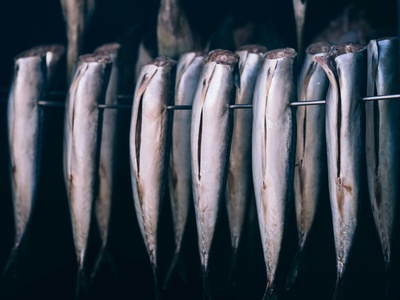
Mackerel scad
A schooling mid-water fish that forms large aggregations around islands and seamounts. Serves as a critical link in food webs, feeding on plankton and feeding larger pelagic predators.
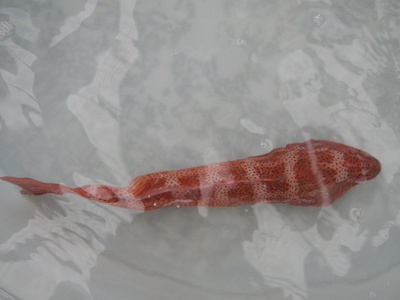
Leopard coral grouper
Beautiful, ambush-hunting grouper prized in fisheries. Prefers rock and coral ledges on reef slopes, where it feeds on smaller fishes. Highly valued both ecologically and commercially.
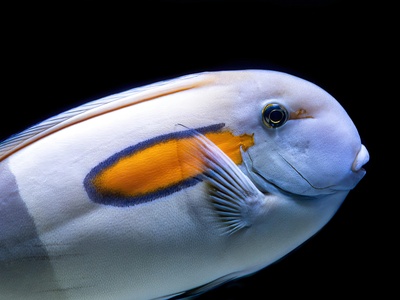
White-spotted rabbitfish
A schooling herbivorous fish that grazes algae in lagoons and seagrass meadows. Plays an important role in controlling algal growth and is a common, culturally recognized species.
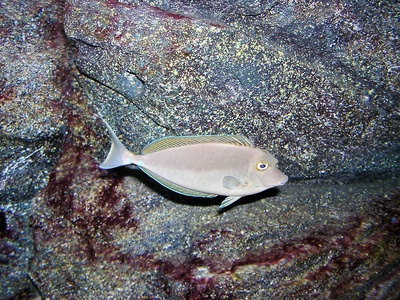
Bluespine unicornfish
Large, laterally flattened surgeonfish with a distinctive forehead and tail spines. Feeds on macroalgae and zooplankton, often seen in small groups on outer reef slopes and passes.
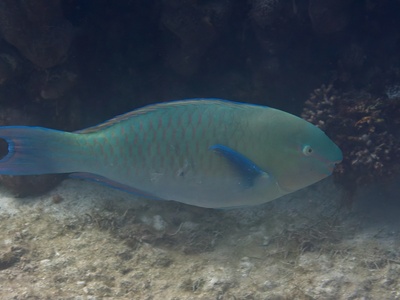
Greenband parrotfish
A large, colorful parrotfish that scrapes algae and bioerodes coral, producing sand. Important for reef resilience and a frequent, charismatic species on Polynesian reefs.
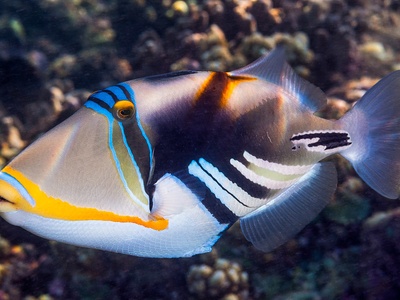
Picasso triggerfish
Bold, patterned triggerfish common in shallow reef zones. Territorial and sometimes aggressive when nesting, it feeds on hard-shelled invertebrates and is easily recognized by snorkelers.
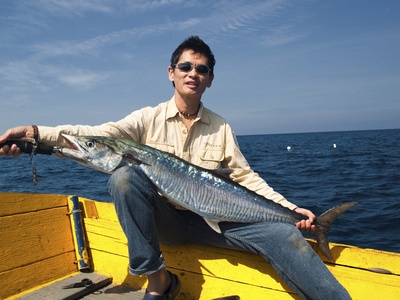
Spanish mackerel
A swift predatory mackerel that hunts schooling fish near reefs and islands. Valued by local fishers and anglers, it’s known for speed and strong fights when hooked.
